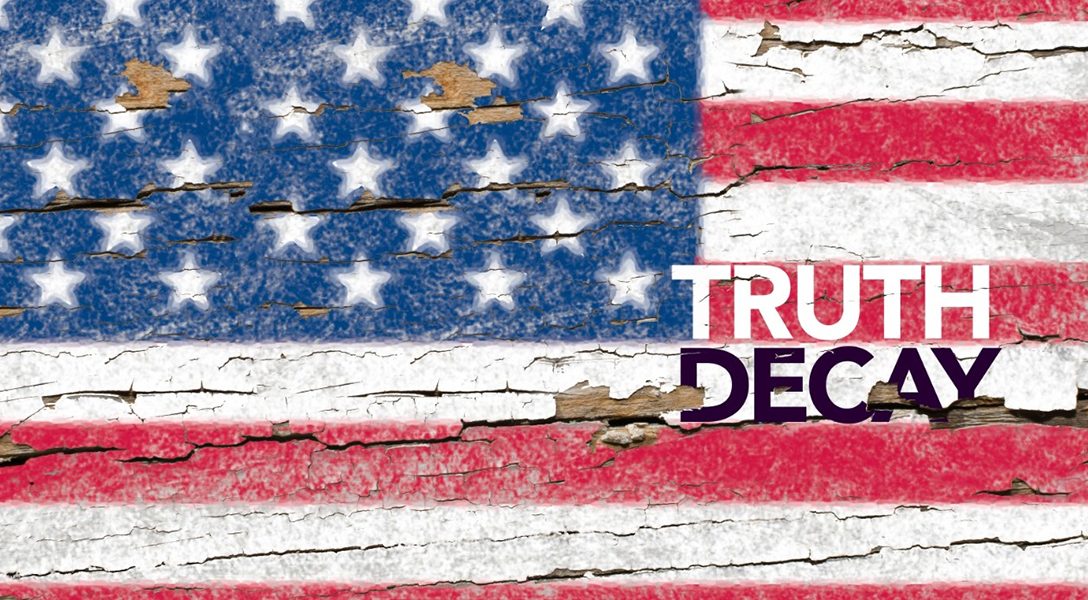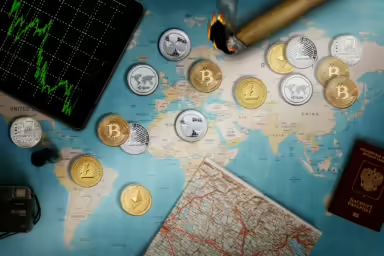A new report from RAND examines how diminishing respect for objective facts is undermining the public marketplace for ideas that forms the foundation of democracy.
The shrinking role of facts and evidence-based analysis in American public life poses a threat to democracy, to policy making, and to the very notion of civic discourse.
This is the alarming conclusion spelled out in the RAND Corporation’s recently released 300+ page report provocatively titled “Truth Decay.” The co-author of this report, RAND political scientist Jennifer Kavanagh, is Jeff Schechtman’s guest on this week’s WhoWhatWhy podcast.
The report’s authors compare what’s happening now in the public arena to four other historical periods when truth was under siege: the era of “yellow journalism,” the rise of tabloids and talk radio, the impact of television on news media, and even the advent of so-called New Journalism.
What the authors found, Kavanaugh says, is that disagreements over objective facts have never been so wide and so deep.
The RAND report examines the growing lack of trust in institutions, the erosion of civil discourse, the ever-worsening political paralysis and lack of policy discussion, and the disengagement of citizens from the political process.
While “Truth Decay”makes many recommendations about how we might unwind all of this, the report also constitutes a warning about the possible end of democracy as we know it.
Click HERE to Download Mp3
Full Text Transcript:
As a service to our readers, we provide transcripts with our podcasts. We try to ensure that these transcripts do not include errors. However, due to time constraints, we are not always able to proofread them as closely as we would like. Should you spot any errors, we’d be grateful if you would notify us.
| Jeff Schechtman: | Welcome to Radio WhoWhatWhy. I’m Jeff Schechtman. Amidst the cacophony of 24/7 news and information that pours in at us every day, we seem to have lost sight of what constitutes truth, facts and real information. The signal to noise ratio has shifted overwhelmingly towards noise. Remember it wasn’t that long ago that we got our information from some local papers and three television networks. The original Cronkite Nightly News was only 15 minutes long. It was a big and controversial deal when it was expanded to a full half hour. In many ways, it feels like we’re at a chicken-and-egg cycle. Technology has helped provide us with endless sources of information, yet we’re also more polarized than ever. Is it the abundance of options that creates the polarization? Or is it the polarization that causes us to seek only information to support our cognitive bias? |
| All of this is part of what a recent report by the RAND corporation calls Truth Decay. RAND recently released a 300-plus-page report on the diminishing role of facts and analysis in American public life. And I’m joined today by one of the authors of that report, Jennifer Kavanagh. Jennifer Kavanagh is a political scientist at RAND and the associate director of the strategy doctrine and resources program. She’s a professor at the Pardee RAND Graduate School. She has a PhD and an MA in political science from the University of Michigan, a BA from Harvard, and it is my pleasure to welcome Jennifer Kavanagh to Radio WhoWhatWhy. Jennifer thanks so much for joining us. | |
| Jennifer Kavanagh: | Thanks for having me. |
| Jeff Schechtman: | One of the things that you talk about early on in the report is that the phenomenon of people distrusting information, or fake information being out there in the marketplace, is an old phenomenon. But there’s something different that seems to have happened in the past two decades. Talk a little bit about that history first of all. |
| Jennifer Kavanagh: | Sure. So we identified four trends as being part of ‘truth decay’ as we’re defining it now. The first is increasing disagreement about objective facts. The second is a blurring of the line between fact and opinion. That combines with the third trend, which is an increase in the relative amount of opinion that we have available to us circulating in the information system. And the fourth is declining trust in institutions. |
| So we took a look back over US history, going back to post civil war time, that was the period that we focused on. And we identified three periods that looked somewhat similar in some dimensions and we looked for evidence of the four trends that we identified as part of truth decay in each of those periods. The periods that we focused on were the 1880s to 1890s, from 1920s to 1930s, and the 1960s to 1970s. What we found was, there is pretty strong evidence of the blurring of the line between facts and opinion and the increasing volume of opinion relative to fact in all of the periods that we considered. | |
| So if you think about 1880s to 1890s, there was yellow journalism which was exceptionalized and sensationalized stories that were spread in new mass newspapers. In the 1920s to 1930s, you have jazz journalism or tabloid style journalism and the rise of radio which was in many ways similar to cable news, with very opinionated hosts using their platforms to spread their opinions to wide audiences. Often those opinions were not based on fact. And in the ‘60s and ‘70s you had propaganda surrounding the Vietnam war and the spread of television as the major source of news information. We also found some evidence of this declining trust in institutions. We see that in the ‘20s and ‘30s after the crash of the stock market in the Great Depression. We see it in the ‘60s and ‘70s directed towards the government as well as the media. | |
| But there are a number of differences between those previous periods. The most striking is that in none of those periods were we able to find evidence of increasing disagreement about objective facts. That was a pretty remarkable finding because it means that that is … what we’re seeing now, while it has parallels in the past, is really distinct. So we tried to dig a little deeper and understand what were the other differences and why that might be. We identified a couple of things worth noticing. | |
| One is while each of these previous periods had changes in the way information was disseminated and consumed, the changes, the scale and the scope of the changes we’ve seen with the rise of the Internet and social media, it’s just on a whole other order of magnitude. Another important difference is the depth of political polarization that we see. We don’t see the extreme level of political polarization, social and economic polarization in the previous periods. So that could be feeding into why we see this disagreement about objective facts. And finally the depth of distrust and the erosion of credibility in our institutions. While we see declines in other periods, the absolute level was still much higher than what we see now. So what we’re seeing now has a different flavor. It has some new elements, disagreement about objective facts and also a different severity or a level of magnitude for some of these other factors that we observed. | |
| Jeff Schechtman: | When we look at the differences in a period say during the ‘50s, during the Red Scare, the McCarthy era and even the Civil War Period, and we look at the disagreements and extreme disagreements that existed in those periods, talk a little bit about why they were different from what we’re seeing now in terms of the polarization today. |
| Jennifer Kavanagh: | Sure, there have always been disagreements about opinions. People have always had different opinions, different interpretations based on their different values or perspectives or priorities. But what we’re seeing now is different because there’s not only disagreement about opinions, not only do people have their own opinions. But we’re seeing fundamental disagreements about objective facts and so that’s different and noteworthy. The other thing I would say is that we’re not only seeing this disagreement about objective facts but we’re also seeing a different level of decay of the social consensus. And a different type of polarization in that it’s these reinforcing lines of polarization. We not only have political polarization but you have economic, social and other types of polarization that occur along on the same lines which creates a very fragmented society and makes it really easy for information to become siloed. |
| Jeff Schechtman: | The irony of course, is that at the same time, it is easier for people to communicate and easier for people to get information that the net effect is this polarization that you’re talking about. |
| Jennifer Kavanagh: | That’s right. And some of that is an unintended consequence of what should be a good thing and that is democratized access to information. We should want more people to have access to more information so that is a good thing. But what that means is that it becomes more difficult to sift through that information and also that some of that information may be of lower quality. And so what we’re seeing is the effects of filters and algorithms and heuristics that people use to screen out information and filter information down into manageable chunks. And so some of this is self- imposed, people seek out information that confirms their biases and some of it is written into the system. So written into the Google search algorithms or the types of information that Facebook and Twitter show their users. Which means that you’re more likely to see certain types of information than others. And so it’s very easy for these echo chambers to form both through the persons’ own intentional decisions about what to consume as well as what they’re shown by these search engines and social media platforms. |
| Jeff Schechtman: | What it seems to have is this cyclical ability to amplify and re-amplify and re-amplify again whatever individual cognitive bias may be. |
| Jennifer Kavanagh: | That’s right. And one of the arguments that we make in the report is that cognitive bias has always existed. This isn’t something new. But what we’re seeing is that these cognitive biases are being magnified by the changes in the information system including the rise of social media, by political, and social, and economic polarization which increasingly pull people into a very insular group and by competing demands on the education system which challenges the ability to provide students with the skills they need to distinguish good from bad information and those skills are becoming so important in the new information environment. |
| Jeff Schechtman: | What is the role as you have found it with respect to civil discourse? Certainly we’ve been through other periods where the coarsening of discourse has been obvious. It seems to be even more magnified today. Talk about that in the context of what we’re discussing. |
| Jennifer Kavanagh: | So our argument about civil discourse — and this relates also to political paralysis — is that when you don’t have a common set of agreed-upon facts as the foundation for a discussion, it becomes really difficult to have meaningful debates with people with whom you disagree. You see that in the political realm. It’s hard to have meaningful policy debates about policy options that are available if you can’t even agree on the starting part for the discussion, the objective facts that should be informing that debate. Certainly people are entitled to their own opinions but there should be that basic set of objective facts. When those objective facts don’t agree … don’t exist, it becomes difficult to have the debate to reach compromise. And what we see more often in civil discourse these days is people shutting down a conversation when the person they’re talking to disagrees with them rather than engaging. And that has implications both for policy making but also just for the quality of democracy, which is founded upon the participation of citizens and the active and engaged debate in a marketplace of ideas. |
| Jeff Schechtman: | And to what extent did that happen or not happen in some of these other periods of conflict that you look at? |
| Jennifer Kavanagh: | So certainly there was a decline in social consensus and wide splintering of opinions about how best to organize the government and what was the function of the government? What type of society do we want to live in? What are the values that are most important? And those debates should and continue to happen now. But what we don’t find at the core of those debates in previous periods and perhaps that exist and we just haven’t uncovered the evidence yet. But what we see now is the reason that those debates don’t seem to go anywhere and the reason that they become so polarized is that there is not a foundation of objective facts. So we’re not just debating about conceptions of what the government should be doing but we don’t even agree on the data or the facts that should be informing that debate. So that’s different about this period, which makes it even harder to address the problem. Because it’s not just a matter of us coming to some kind of compromise, it’s a matter of us even establishing those basic facts on which to start the debate. |
| Jeff Schechtman: | To what extent is the degree to which information has become a kind of consumer entertainment? To what extent that does play a role in this today? |
| Jennifer Kavanagh: | So I think that plays a big role. We talk about the blurring of the line between fact and opinion and that could include the blurring of the line between fact and commentary, between news and entertainment. And when you turn on the TV, or you listen to the radio or even when you read news online, a lot of time what people are looking for isn’t just the straight facts but they want those facts spun a specific way. And they turn on the TV for that entertainment value. And when news becomes entertainment, people are no longer demanding the hard facts. Media companies then don’t have the market incentive to spend the money to provide that deep investigative journalism. So there’s both a supply side and a demand side. And the fact that news is now viewed as entertainment plays a big role in that. |
| Jeff Schechtman: | Can you identify, have you identified some kind of tipping point in the past two decades that really was a fulcrum moment in getting us to where we are today? |
| Jennifer Kavanagh: | We have not identified a specific tipping point. There may be one but really we’ve been focused more on the trends. We see this decline in the reliance of facts and data in political and civil discourse unfolding over the past two decades and we can’t exactly tie it to a specific event or specific political actor. Instead what we’re looking at is how it unfolds. It’s likely that it may just be a confluence of events or a confluence of factors. It could be that we have these massive changes in the information system combined with certain demographic and economic patterns that contribute to polarization combined with any other type of factor that we see going on, challenges to our education system coming from other directions. And the fact that all four of these different factors come together at once is how you end up with what we’re seeing now. |
| Jeff Schechtman: | There also seems to be greater pressure in this period of massive amounts of information for greater literacy and greater critical thinking skills which are in shorter supply. |
| Jennifer Kavanagh: | That’s right. And that’s why we focus on these competing demands on the education system. As the information system becomes more complex, the skills to distinguish good from bad information become increasingly important. But our school system already faced numerous demands and a shrinking fiscal constraint. So that creates a large challenge that they have to address. Like any institution, schools change slowly. So we’ve seen a lot of progress over the past five or so years in terms of the development of media literacy and civic literacy programs. But still the schools have not yet closed that gap between the skills they provide the students and the demands that the information system places on them. And that means that things like media literacy, social studies, civic literacy, sometimes statistics, training to help people understand infographics, that sometimes gets crowded out. And the problem is even worse than that because it’s not just students who are affected, obviously also adults who weren’t trained this way in school. And so that gap between skills and demands I think is a big part of the problem. |
| Jeff Schechtman: | When did we start to see this decline in the value of expertise? |
| Jennifer Kavanagh: | Well again, I don’t know that I would put it at a specific point. I think that we’ve seen an erosion in credibility and trust in institutions that used to be key providers of information. And that combined with this increasing disagreement about objective facts has led to a questioning of what makes an expert and which expert should be trusted. So I think again, it’s being more of a process and that’s why we’re calling it truth decay because decay naturally indicates a process. |
| Jeff Schechtman: | There is also this effort that goes on on the part of those that are trying to make an argument to destroy the credibility of facts and information that comes from institutions that are in disagreement with their point of view. |
| Jennifer Kavanagh: | That’s definitely true. It is a concerning trend and it’s one of the main reasons that we wrote this report. One of the reasons that we wrote this report and one of the reasons why we really tried to focus on the hard-line consequences of truth decay was that we wanted to get across the point that facts really do matter. And that there are economic and other consequences to ignoring them in policy making and political debate. So I think our perspective as we’re writing this report is that understanding facts and having facts involved in the debate and in policy decision making is very very important. |
| Jeff Schechtman: | One of the points you make, and it’s so fascinating, is that in other areas outside of the governmental realm, the political realm and some of these areas that we’re touching on, that in business for example, and in other areas, the trend is towards more information, towards big data, more facts in order to make decisions. |
| Jennifer Kavanagh: | That’s right. And one of the questions then is why don’t we see the same trend in the political and civil discourse area. One possibility — this is an area that we’re still exploring — but one possibility is that it’s about accountability. In business and in sports, if you don’t use data appropriately, you end up with bad consequences. And you have either shareholders or your fans or your team owners to hold you accountable. And in the political sphere, in order to make sure that we get facts in there, people have to demand them. Which is why we in the report focus not only on thinking about a supply side response, what can we do to improve the quality of information? But also a demand side, how can we teach people to demand facts and teach them to understand why facts are important? |
| Jeff Schechtman: | One of the questions that it raises powerfully is the degree to which our system of government, the degree to which our kind of democracy, is or isn’t able to function in this kind of information environment today. |
| Jennifer Kavanagh: | Well, I think that one of the reasons we wrote this report, my co-author Michael and I felt that this … the truth decay is a very important and serious threat to American democracy and to the health of that democracy. Facts and debate and having an objective set of agreed upon facts is the foundation of policy making and policy decisions; is very important to the survival of democracy at least in, as you said, the type of democracy that we have in the United States. And so we were motivated to write this report because we were concerned about the consequences that truth decay might have for our institutions going forward. |
| Jeff Schechtman: | Talk a little bit about how you see the role of journalism today and also within the framework of some of the historical precedents you look at. |
| Jennifer Kavanagh: | One of the things we noticed looking at the historical examples is one of the things that seems to end, periods that seemed similar to truth decay in the past is a return to really hard-hitting investigative journalism. And some of that is demands-driven, people demanding it. And some of it is a supply-side function, journalists wanting to provide it, newspapers demanding that it be provided, codes of conduct and standards that appear in the newspaper industry say in the 1910s following the yellow journalism would be one example. So one thing that we see is that an increase in investigative journalism now could be one solution or one way to work against truth decay, the question is how do we motivate that type of response. And again, I think it has to be both demand- and supply-side driven. |
| We talk about agency in the report and the role that different types of actors play in amplifying the trends of truth decay. And while we include the media there as an agent that can … that certain media outlets do contribute to the blurring of the line between fact and opinion and do contribute to the problem either intentionally or unintentionally. We also want to be clear that journalism could also be part of the solution in terms of really reinserting the facts into debate and making sure that investigative journalism comes back and becomes more the norm. | |
| Jeff Schechtman: | Of course, journalism itself is one the institutions that is under attack in this framework. |
| Jennifer Kavanagh: | Well, that’s true. People have lost a lot of trust in the media. Some of that is … obviously institutions need to earn the trust of the constituency that they serve. And certainly instances where journalists or media organizations have been misled or misleading in their reporting doesn’t help rebuild trust. One of the things that we’re trying to do here at RAND right now is [inaudible 00:20:28 follow-up work?] understand why trust has declined, why the trust in the media and the government has declined so badly. And try to think about ways, lessons that we could draw from institutions that have been able to retain public trust in order to help rebuild trust in institutions like journalism. And like the government where people trusting in the information provided in those institutions seems to be an important part of stability of democracy. |
| Jeff Schechtman: | Which raises the question, what do people trust today? What are those institutions that have high levels of trust? |
| Jennifer Kavanagh: | Well, the institution that has probably the highest and even sometimes increasing levels of trust is the military. That could be because we look to the military for different things. We don’t look to them necessarily for information all the time. We’re looking to them for … to protect national security. The data that we have only goes back to the mid ‘70s so we don’t know what that looks like say during the Vietnam war but at least right now. Public schools have done pretty well in terms of retaining public trust. The medical community has done pretty well in retaining public trust. So those are some of the ones that we might look to as examples why do people trust these specific types of organizations. Is it because of how they’re organized? Is it because of what they provide or what people expect of them? And obviously trust is also a very complex concept that includes things like approval and confidence and do I think that the government is representing my best interests. So we’ll need to tease out what all those different pieces of trust are. |
| Jeff Schechtman: | While that’s going on, while we begin to examine these things, those very institutions — public schools are a good example — are having trust and confidence chipped away at them at the same time. That it’s not a constant in terms of looking at those institutions. |
| Jennifer Kavanagh: | No, that’s definitely true. The aggregate levels of trust in those institutions has been pretty stable over the past at least 10 to 15 years. But certainly that doesn’t mean that everybody trusts them at a stable level, right? That’s an aggregate trend and we set … so we need to disaggregate it and understand how trust has changed in specific groups for these different types of institutions and that’s definitely something we’re trying to dig in more deeply to understand the data, to understand which groups trust which institutions most and how that’s changed over time. |
| Jeff Schechtman: | The other part of this is trying to understand perhaps at the same time how to begin to unravel this, how to unwind this predicament that we’ve gotten ourselves into. |
| Jennifer Kavanagh: | That’s right. And that’s one of the purposes of our report. Is to lay out a strategy for addressing truth decay. And one thing that we try to make clear is that there’s a lot we still don’t know and we’ll need to collect more data and do more analysis to understand the problem better and to collect data to understand the areas where it’s most severe. But some of the areas where we’re thinking about responses that might be more valuable are education which we already talked about. Increasing the number, and types, and effectiveness of media literacy or civic literacy programs not only in schools but also as outreach to adults. Another is to think about changes in the media market, including not only regulations which obviously would need to be consistent with the first amendment, but also market incentives or different types of funding that might encourage investigative journalism or encourage the use of facts. |
| Another, thinking about the research and academic community which also plays a role in this is thinking about ways we could do a better job or ways that experts could do a better job in communicating technical findings in a way that people find tangible. So maybe then there isn’t as much room for distrust in those areas. So these are some of the things that we are trying to look into and to understand whether responses like these would be effective and if not then what would work. And if so, then how do we implement them? | |
| Jeff Schechtman: | Is there a way, or have you looked at in the broader context, trust in individuals versus trust in institutions? Because we seem to have this habit, and it’s part of the entertainment aspect we talked about before, part of celebrity culture even which we’re living with in this rubric today, that we build up somebody, we build up trust in them only to really do that as a way to tear them down. |
| Jennifer Kavanagh: | Well, there definitely is a trust … a difference between trust in individuals and trust in institutions and you can see that in the data. But if you ask people, do you trust your representative in congress? People tend to have much higher levels of trust for those individuals than they do say if you ask them, do you trust congress? People tend to trust their doctor more than they trust doctors writ large. And I’m not sure why that is? It would be because there is an immediacy. I trust someone that I know and that I’ve talked to whereas I don’t trust someone … I don’t trust this big institution that I can’t put my hands around, that I don’t understand. But I think that’s an area that probably needs more research. |
| Jeff Schechtman: | And that does seem to be in some ways, the thing you just touched on in terms of what people know, what they can touch, and talk to, and feel, is that in order to build this back up, build this trust back up and unravel this, maybe it has to start on the most basic, fundamental, local level that we’ve gotten away from in many respects. |
| Jennifer Kavanagh: | I do think that’s right. The research is pretty clear that in order to overcome cognitive bias or reduce cognitive bias which is obviously a fundamental part of this, one of the most important aspects is this idea of a trusted messenger. And it’s not just about providing factual information but making sure that factual information comes from a trusted source for the person who is being communicated to, and also the way that message is communicated. So I think as much … we can think about lots of big top down responses but I think you’re right. That a lot of this is going to have to be from the bottom up and it’s going to have to be person to person. It’s going to have to be a small response first that aggregates to something bigger. |
| Jeff Schechtman: | What have we come to understand, and is it worth looking further into the origins, the psychological, the neuroscience origins of individual cognitive bias? And how they work to better understand how they’re interacting with all these outside forces we’ve been talking about. |
| Jennifer Kavanagh: | Well, I think there’s actually a lot of research done on cognitive bias. I mean it’s something that is just fundamental in the way we process information which has to do with both our … the limitations of our bandwidth. How much information we can hold in there at once and how we make decisions and how we interact with other people who have similar and different views than us. And there’s a lot of research going on now that’s trying to look at what we can learn about cognitive bias in the current context and what that might mean for overcoming or reducing the effects of cognitive bias on the spread of miss- or dis-information. So there are several universities that are doing really interesting experiments, both lab and survey experiments to try to get a better handle on this. |
| Jeff Schechtman: | One of the other areas that you look at are the consequences of all of this if we continue down the path that we’re on now. |
| Jennifer Kavanagh: | We identify four consequences. The first is an erosion of civil discourse which we already talked about a little bit. This is the inability to have meaningful disagreements and discussions with someone who holds a viewpoint that is opposite to yours and the tendency to shut things down. And again, our argument is that this arises because there is not this agreed upon foundation of objective facts. Same thing political paralysis. When you don’t have commonly agreed upon objective facts as the foundation of policy debates, it becomes that much more difficult to have a real conversation about policy actions and to come to compromise. And what you end up with can be political … government shut downs which we saw just a couple of weeks ago which have enormous economic costs. As an example, the shutdown in 2013, estimates suggest that it resulted in 15 to 20 billion dollars of lost GDP for the United States. And it can also result in rapid policy reversals and that does not have good implications either for the policy-making process or for really economic or national security. |
| The third is disengagement or alienation from the political system. And what this refers to is the process or the tendency of individuals to simply opt out of the political system because they just do not trust the institutions. There is too much noise, too much information and so they choose not to participate. And this is really serious because as a democracy, we are … Democracy requires that individuals participate and are engaged and involved in political decision making. So if we lose that, then what is the democracy based on anymore? And then finally uncertainty, uncertainty on national policy that affects business decision making, individual decision-making about buying healthcare or financial planning and also has diplomatic consequences. When our allies and adversaries are uncertain of US intentions, it can affect their decision making which can have serious national security consequences. | |
| So I think what we try to underscore is that the consequences of truth decay are not theoretic or just academic. They are tangible and have real impacts for individual lives. | |
| Jeff Schechtman: | And is there any difference as you look at this through the lens of generational cohorts? |
| Jennifer Kavanagh: | I don’t think it operates on a generational pattern. I think that everyone is pretty much susceptible to truth decay. It may just be a matter of the exact mechanism through which that occurs. So we know that young people are more likely to use social media and more likely to use social media to get their news. Social media has advantages in that it provides a lot of diversity of information if people choose to consume it. It has disadvantages in the sense that that quality isn’t always very high and it’s very easy to get sucked into an echo chamber. However you look at older generations who are relying on print or television news. They may not get any diversity and maybe just be from one or two sources, and again there are still questions about the quality in these … the degree to which it becomes an echo chamber. So I think that no matter sort of which generation you’re in, you’re susceptible to the effects of truth decay. |
| Jeff Schechtman: | Jennifer Kavanagh, the report just out from RAND corporation is Truth Decay, the Diminishing Role of Facts and Analysis in American Public Life. Jennifer, I thank you so much for spending time with us today here on Radio WhoWhatWhy. |
| Jennifer Kavanagh: | Thanks so much for having me. It was really great to discuss the report with you. |
| Jeff Schechtman: | Thank you. And thank you for listening and for joining us here on Radio WhoWhatWhy. I hope you join us next week for another Radio WhoWhatWhy podcast. I’m Jeff Schechtman. |
| If you liked this podcast, please feel free to share and help others find it by rating and reviewing it on iTunes. You can also support this podcast and all the work we do by going to whowhatwhy.org/donate. |
Related front page panorama photo credit: Adapted by WhoWhatWhy from concrete (jon hayes / Flickr – CC BY-NC 2.0).






